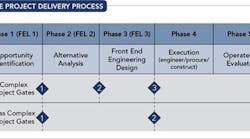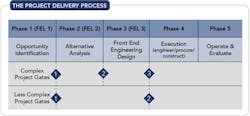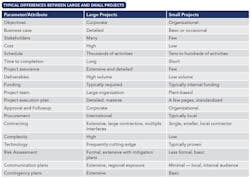The project portfolios of many operating companies are shifting from major capital projects to more-modest in-plant ones. This requires an adaptable/scalable project delivery process (PDP) that supports the execution of these projects. Certain aspects of the process apply to all projects, while others only relate to major or more-complex ones. These project-specific planning and execution activities frequently are misunderstood and inappropriately applied — causing excessive project deliverables for some projects but missed steps for others. This inconsistent application of project delivery activities lowers the value generated from the capital employed.
The change in capital project portfolios varies from industry to industry. The reshaping happening in the chemical and refining sectors reflects uncertainties about future oil prices, the potential impact of shale oil as well as technological advances and environmental demands that aim to replace or reduce the consumption of fossil fuels.
The 2014–2015 drop in oil prices by itself significantly reduced the revenue stream of all oil producers, big and small. This resulted in deferral or redimensioning of large projects; many have been split into smaller projects.
This is not a small change. It requires an important alteration in the approach and resources needed for developing the redimensioned or redefined projects now in the portfolios. The number of projects probably has changed but, more importantly, many (if not most) of those projects now are smaller.
Key Differences In Projects
Large and small projects need different tracks for approval, follow-up and execution. While large projects involve a significant number of complex deliverables, small ones typically require a more simplified approach. Consider a very simple analogy — digging holes. If our task (project) was to dig large holes, then probably we’d need an excavator, bulldozer or backhoe. However, if the task has been rethought and now asks for much smaller holes, maybe we only require a simple shovel. This makes a major difference in how things should be done. Instead of contracting for a large piece of equipment and a specialized operator, now we only need someone with a hand tool. The equipment, the “operator” and the skills aren’t the same. Failing to recognize this fundamental differentiator will significantly impact the efficiency, quality, cost and schedule in executing the project. By definition, a bulldozer can’t dig small holes and, in turn, you wouldn’t use a shovel to dig an enormous one.
In this analogy, the difference is very easy to identify and visualize. However, in a real project, the difference sometimes isn’t as apparent because size isn’t the only relevant parameter to consider. You may need to review and analyze factors such as technology, strategic importance, complexity, etc., when characterizing a project and defining the right track in the PDP for its successful development/execution.
Regarding the approval and follow-up, the projects of utmost strategic significance, high cost and complexity require the involvement of corporate levels of the organization. This is natural considering the level of resources that such projects demand. On the other hand, engineering, maintenance or operational groups generally directly decide about the planning and execution of small capital projects in a process facility, such installing metering systems, new pumps, storage tanks, pipeline loops/bypass, replacing a vessel or revamping or updating utilities. So, as Figure 1 shows, a smaller project doesn’t require a phase gate at every stage of front-end loading (FEL).
Figure 1. A small project should involve fewer phase gates.
Think about a large upstream project such as an offshore platform involving a jacket, drilling, topsides, tie-back operations, extensive use of supply vessels, transport and heavy lifting of equipment or whole units and facilities. An operation of this magnitude demands careful planning, design, coordination and integration of thousands of components, many of them fabricated and transported from different parts of the worlds. The specifications, drawings, procedures, etc., to completely define each component and the procedures for assembling, commissioning, starting up and testing such facilities are extraordinary. Each deliverable should be carefully developed at a very high level of detail following protocols (project assurance) that repeatedly, and in a timely manner, check the planning, quality of the design, constructability and integration of the facility. Such protocols include conducting independent reviews, readiness assessments, benchmarking, safety reviews, integrity reviews, as well as extensive use and application of value improving practices (VIPs), just to name a few. If the components can’t be integrated, are late, don’t comply with specifications and standards due to failure in properly designing, specifying, following up, or installing any of the components, the facility won’t work. This will mandate extensive rework, additional financial resources, and more time for completing and commissioning. Time to market, expected revenue and profits, and competitiveness will suffer by using resources inefficiently and ineffectively. For these reasons, the development, control, quality assurance and timely integration of all the deliverables of major capital projects is of paramount importance; this calls for careful implementation of all the steps of a sound PDP in all its details.
On the other hand, small projects or ones with low complexity or limited technological challenges typically require more modest resources in terms of project team size and skills, contractor’s capabilities and financial resources. Some of these projects might even be executed in a similar or repetitive manner, or by applying just a limited number of project assurance protocols, considering the typical short duration of such projects. As a consequence, the number of deliverables to fully specify/design the project or its components is very limited. These small projects, because of their size or low complexity, are easier to visualize and understand.
The Impact On Approach
The differences between large and small projects are extensive, many of them of significant importance and affecting all (or most) of the steps of typical PDPs. Table 1 compares large and small projects for some typical parameters/attributes associated with PDPs. It points up why you should take these major differences into account when defining or deciding the proper track for a particular project. All major projects should implement and follow, in detail, the instructions or provisions associated with each step of the PDP. However, for smaller projects, and depending on their nature and characteristics, we either skip some of the steps — e.g., business case, contingency plans, communications plans, application of benchmarking and VIPs (as part of project assurance), etc. — or reduce or scale down the level of detail required by some of the steps (e.g., project execution plan, schedule level, risk assessment, etc.).
Table 1. Smaller projects don’t pose the same issues as larger ones.
Let me reiterate: rigorously applying all PDPs steps and protocols to small projects will waste resources, extend project execution time, add costly test/procedures, likely enlarge the project team and lead to more expensive contracts. The magnitude of the project simply doesn’t justify such extra effort, time and cost.
Clearly, determining the proper PDP track for a project is important to ensure an efficient use of valuable resources and optimize the project execution in terms of cost and time.
A Valuable Tool
Most organizations are rebuilding their PDPs to respect their repositioned capital programs as well as to address the issue of less-experienced project teams. This has generated the need for a project characterization step and its supporting documentation/tool. Such a characterization step (through its tool function) directs the team through a series of questions whose answers can guide in adapting the PDP to one that best suits the project’s needs. This characterization isn’t based solely on project expenditure or cost but also takes into account new or existing technology, required completion date, resource availability, etc. The resulting evaluation directs the process to turn on and off various project planning and execution activities, which then leads to the appropriate level of work to drive the project to completion.
The tool provides a suggestion that can be overridden if the project team and the gate-keeping team agree that other activities should be implemented or avoided. The overall objective of the tool is to apply the truly value-added steps in the PDP and eliminate the non-value-added work. Effective implementation of this step has resulted in minimizing excessive project planning paperwork, utilizing appropriate owner resources and, ultimately, achieving cost and schedule savings.
A characterization tool typically is tailored to the owner organization’s PDP and project complexity parameters. In some industries, companies might consider capital projects of less than $25 million small, others would define a small project as one costing under $1 million. The definitions of other parameters outlined above also vary widely. Therefore, an initial activity in developing this PDP characterization step often is an alignment session around the owner’s philosophy of requirements at each phase of project delivery for various project types. This then results in an activity to document these criteria and build the tool. These activities shouldn’t take longer than 2–3 days to complete but add great value in clarifying the expectations of senior management and the project team at each of the phase gates.
Figure 2 illustrates a portion of a characterization tool. The tool tends to be specific for particular industries and even companies; the version shown just provides an example of the factors and associated questions used to determine the right track for a project when implementing the PDP steps.
This example, suitable for projects in the oil-and-gas downstream sector, considers three major factors:
1. Technical complexity — in terms of commercial challenges, key project-specific parameters and technology consideration or sensitivity, i.e., proven vs. cutting edge technology; licensed vs. open technology; capital cost vs. operating costs vs. life cycle costs; safety issues associated with competing technologies; etc.;
2. Size, represented by cost/value; and
3. Special project drivers such as expected revenues, regulations or challenges associated with the execution and its constraints.
As indicated, the factors, questions and relative weight of each issue considered typically are industry- and, many times, company-specific. So, selection generally takes place in a facilitated workshop, bringing together the business strategic vision and the project management expert knowledge.
In the example shown, with the exception of the project value information (value at risk), the tool only requires yes/no answers. It internally applies the conversions, weights and grades agreed to in the workshop, resulting in a characterization of the project into one of three classes where Class 1 represents the upper level in terms of criticality and Class 3 the lower end. In this particular case, the classification of projects into three categories allows the definition of a project’s “routes” or “tracks.” The team then selects activities, steps, tests and procedures the project should follow consistent with its class. The effort and resources for developing the projects then are optimized, the critical projects are identified early in the project cycle and receive the attention their complexity demands while less-critical projects aren’t subject to heavy procedures that risk unnecessary and auto-inflicted overruns in cost and time.
Before its application, the tool needs customizing for the particularities of the industry/company the project is in. This usually brings some other relevant perspectives worth exploring during the characterization process such as: PDP considerations and simplifications in case of projects of repetitive nature; complexities derived from very sensitive site locations (i.e., ecological issues); contractors’ market conditions substantially affecting contracting strategies; few suppliers for key components or services; insufficient owner skills or resources to exert project oversight; etc. Simple projects can migrate quickly into a complex condition when combined with some of these issues.
Figure 2. Tool uses yes/no answers for most questions and pre-determined weights to place project into a particular class.
Typical misconceptions about project complexity include:
• Working on the basis that all projects are equal and the same PDP process applies;
• Using size (i.e., dollars) as the only characterization factor;
• Disengaging or limiting senior business and operational participation during the characterization process, or avoiding proper periodic project oversight during the FEL by these functions;
• Underestimating the importance of developing a formal business case that includes sensitivity analysis as the basis for project characterization;
• Assuming that selection of a low-level project track means lack of rigor in developing and reviewing the project deliverables;
• Characterizing the project without previously defining and approving the business and project objectives; and
• Failing to match the project team’s profile and skills to project characteristics and requirements/challenges.
Finally, it’s important to keep in mind that the relevance and applicability of these issues and factors depend upon industry sector. Every industry has particular factors that always deserve serious consideration or proper emphasis when characterizing a project. These factors include:
• Geopolitical factors and organizational/coordination challenges (i.e., large oil-and-gas upstream/downstream);
• Communities and regulations (i.e., pipeline, oil-and-gas midstream);
• Patent protection, regulations and validation requirements (i.e., pharmaceuticals);
• Financing options, efficiency, contracts’ synchronization (i.e., power); and
• Quality/complexity of mineral deposits, availability of infrastructure, location (i.e., mining).
Upgrade Your Approach
The characterization tool should become a mandatory addition to an owner’s PDP. It enables differentiating between projects of varying nature and characteristics to optimize the use of organizational resources — eliminating non-value-added work and producing significant savings in cost and time.
IVAN CRESPO is vice president of Pathfinder LLC, Cherry Hill, N.J. Email him at [email protected].





